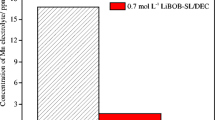Abstract
Many attempts have been made to make the zinc-manganese dioxide (Zn-MnO2) alkaline cell rechargeable, but all investigations are pertained to the proton insertion mechanism into MnO2. In this paper, a new class of rechargeable bismuth oxide-doped MnO2 electrode in lithium hydroxide (LiOH) electrolyte is described. The doping and the appropriate pH selection of the aqueous electrolyte improved the electrochemical performance of the aqueous cell. Hence, with an aim to understand the role of bismuth oxide (Bi2O3) during the discharge process, doped MnO2 cathodes are characterized by various techniques like secondary ion mass spectrometry, X-ray diffraction, Fourier transform infra-red spectroscopy, and transmission electron microscopy analysis. The results suggest that the influence of the large radius of the cation (Bi2O3; Bi (III) ion (0.96 Å)) cannot be integrated into the spinel structure, thereby, improving the rechargeability. The electrode reaction of doped MnO2 in LiOH electrolyte is shown to be lithium insertion while preventing the formation of a spinel structure that leads to a major formation of manganese oxy hydroxides.







Similar content being viewed by others
References
Fritsch S, Navrotsky A (1996) J Am Ceram Soc 79:1761, doi:10.1111/j.1151-2916.1996.tb07993.x
MacNeil DD, Lu Z, Chen Z, Dahn JR (2002) J Power Sources 108:8, doi:10.1016/S0378-7753(01)01013-8
Greenwood NN, Earnshaw A (1984) Chemistry of the Elements, 1st edn. Pergamon, Oxford
Boden D, Venuto CJ, Wisler D, Wylie RB (1968) J Electrochem Soc 115:333, doi:10.1149/1.2411182
Sajdl B, Micka K, Krtil P (1995) Electrochim Acta 40:2005, doi:10.1016/0013-4686(94)E0163-T
McBreen J (1975) Electrochim Acta 20:221, doi:10.1016/0013-4686(75)85028-6
Im D, Manthiram A, Coffey B (2003) J Electrochem Soc 150:1651, doi:10.1149/1.1622960
Kordesch K, Weissenbacher M (1994) J Power Sources 51:61, doi:10.1016/0378-7753(94)01955-X
Mondolini C, Laborde M, Rioux J, Andoni E, Levy-clement C (1992) J Electrochem Soc 139:954, doi:10.1149/1.2069374
Kozawa A, Powers RA (1996) J Electrochem Soc 113:870, doi:10.1149/1.2424145
Minakshi M, Singh P, Issa TB, Thurgate S, DeMarco R (2004) J Power Sources 130:254, doi:10.1016/j.jpowsour.2003.12.018
Minakshi M, Mitchell DRG (2008) Electrochim Acta 53:6323, doi:10.1016/j.electacta.2008.04.013
Minakshi M, Singh P, Carter M, Prince K (2008) Electrochem Solid-State Lett 11:145, doi:10.1149/1.2932056
Bach S, Ramos JPP, Baffier N, Messina R (1995) Electrochim Acta 40:785, doi:10.1016/0013-4686(94)E0170-5
Ghavami RK, Rafiei Z, Tabatabaei SM (2007) J Power Sources 164:934, doi:10.1016/j.jpowsour.2006.10.084
Wroblowa HS, Gupta N (1987) J Electroanal Chem 238:93, doi:10.1016/0022-0728(87)85167-7
Gao YF, Gupta N, Wroblowa HS (1987) J Electroanal Chem 238:107
Kordesch K, Gsellmann J, Peri M, Tomantschger K, Chemelli R (1981) Electrochim Acta 26:1495, doi:10.1016/0013-4686(81)90021-9
Raghuveer V, Manthiram A (2005) Electrochem Commun 7:1329, doi:10.1016/j.elecom.2005.09.012
Novak A (1974) Struct Bonding, Berlin 18:177–216
Wu YT, Hu CC (2005) Electrochem Solid-State Lett 8:A240, doi:10.1149/1.1874673
Aurbach D, Daroux ML, Faguy PW, Yeager E (1987) J Electrochem Soc 134:1611, doi:10.1149/1.2100722
Qu D, Diehl D, Conway BE, Pell WG, Qian SY (2005) J Appl Electrochem 35:1111, doi:10.1007/s10800-005-9005-y
Kannan AM, Bhavaraju S, Prado F, Manivel Raja M, Manthiram A (2002) J Electrochem Soc 149:483, doi:10.1149/1.1459713
Acknowledgements
The author would like to thank the Australian Nuclear Science and Engineering for providing financial assistance (AINGRA award 08048) to enable work on SIMS facilities at Australian Nuclear Science and Technology Organization.
Author information
Authors and Affiliations
Corresponding author
Rights and permissions
About this article
Cite this article
Minakshi, M. Improved performance of Bi2O3-doped MnO2 cathode on rechargeability in LiOH aqueous cell. J Solid State Electrochem 13, 1209–1214 (2009). https://doi.org/10.1007/s10008-008-0648-6
Received:
Revised:
Accepted:
Published:
Issue Date:
DOI: https://doi.org/10.1007/s10008-008-0648-6




